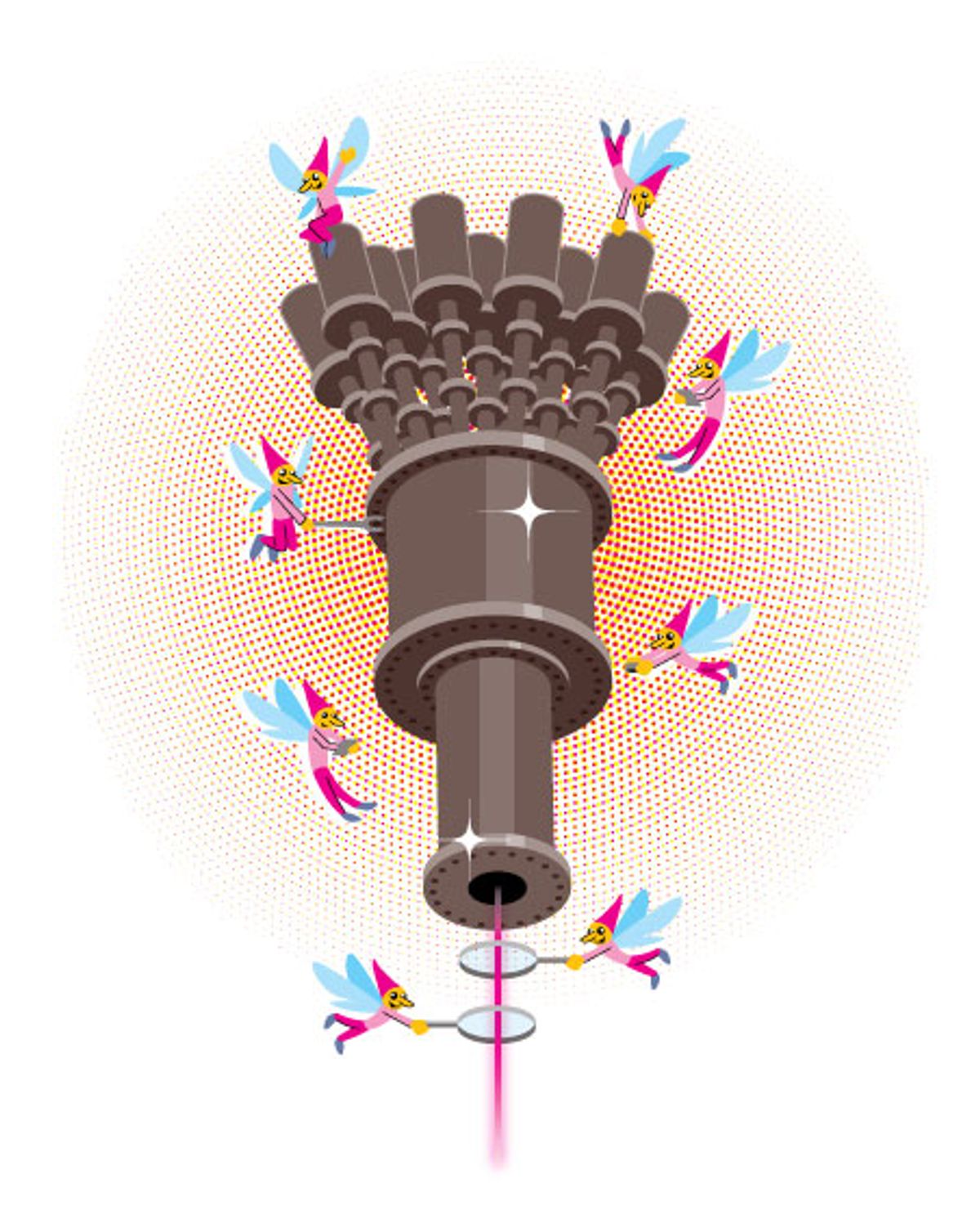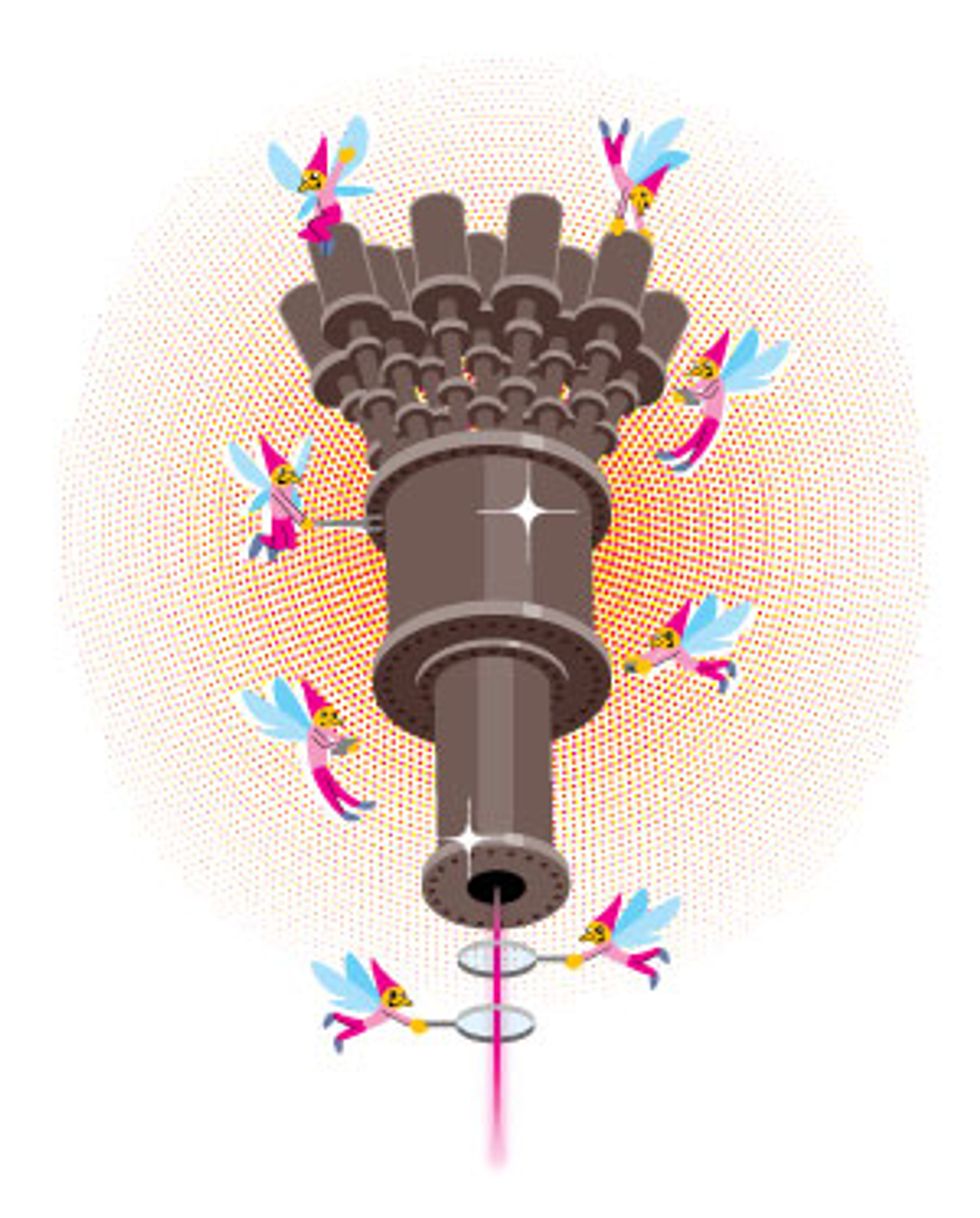Loser: Dim Prospects for NanoUV’s Bright Light
NanoUV’s unproven light source won’t shine in the next-gen lithography market

This is part of IEEE Spectrum's special report: Winners & Losers VII

Using ultrashort light rays to print tiny features on integrated circuits has long been a dream of chipmakers, but suppliers of the necessary tools have been dashing that dream for a decade. The sources remain too weak to print more than a handful of wafers per hour, and critical parts still lack funding. As a result, Sematech, the chip-industry consortium, recently suggested that the expected rollout of the technology in 2013 might be jeopardized yet again.
“EUV’s been this bride waiting at the altar,” says G. Dan Hutcheson, CEO and chairman of VLSI Research, a firm in Santa Clara, Calif., that tracks the chip industry.
Here comes the latest bridegroom. Start-up nanoUV says it has created the world’s brightest EUV light source. The trouble is, the company won’t reveal to more than a handful of players how its technology works, making it hard to rack and stack against other options.
EUV, or extreme ultraviolet light, is a euphemism for soft X-rays, things that everybody in Silicon Valley knows are devilishly hard to make and focus. Whatever you call it, the radiation is attractive because its waves are around 13.5 nanometers—about as small as the features in the next generation of chips—so using them avoids the current need to print features far smaller than the wavelengths of light used to do it.
One big problem with such short rays, though, is that they get absorbed by pretty much everything, including air and glass. So you need special multilayer mirrors to focus them. A far bigger problem is that, after more than a decade of effort, nobody can yet make a decent light source. Cymer, Gigaphoton, and Xtreme Technologies, the leaders in this field, generate their EUV photons in hot plasmas that spit out fast-moving particles, making it hard to protect their light-collecting optics from the heat and debris.
We’ll do you one better, proclaims little nanoUV. The company—headed by a Brit, based near Paris, boasting a Russian chief scientist, and backed by 8.7 million (US $13 million) of venture capital from the United Arab Emirates—says its technology replaces the vulnerable light collector with a lens that’s indestructible because it, too, consists of plasma.
According to Peter Choi, nanoUV’s president and director of technology, the source has two plasmas—a very hot, tiny one surrounded by a cylindrical one. The farther you move from the center, the cooler the outer plasma becomes, dropping to a positively brisk 10 000 kelvin at the rim. As the density increases, the index of refraction decreases, which means the EUV rays bend more at the edges than in the middle, thus converging on a point. The device requires more input power than the leading light source candidates, Choi says, but because it’s just a few centimeters long, hundreds of sources can be “multiplexed” in a many-headed “Hydra” pattern for greater output power and brightness.
The company plans to showcase two versions of its Hydra source (4- and 12-headed variants) at the SPIE conference on advanced lithography, to be held in February in San Jose, Calif. “What they claim to be able to do is revolutionary,” says Gregory Denbeaux, an assistant professor in the College of Nanoscale Science and Engineering at the State University of New York, at Albany. “If it works.”
But will it? So far, few outside of nanoUV have even seen the plasma lens. Company researchers don’t publish in peer-reviewed journals, nor do they give demonstrations to people without first requiring them to sign a nondisclosure agreement. NanoUV won’t even reveal which companies have agreed to take a peek in return for keeping mum.
Glenn Leedy, an inventor with several patents in semiconductor processes, says that after looking at what little information he could find on nanoUV’s plasma lens, “it sounded rather magical to me.”
Another skeptic is David Ruzic, a plasma expert at the University of Illinois at Urbana-Champaign. “It’s not easy to bend EUV light to where you want it,” he says, though he doesn’t believe there’s any “mysterious physics” in nanoUV’s process. “The big question is whether or not it really works in practice, and with the reliability needed for a product.”
Choi says nanoUV is playing its cards close to the vest because it doesn’t want a bigger competitor to see its idea and “improve it better than we can.” While the company holds a patent on the generic use of a plasma lens to collect light (WIPO Patent No. 2005038822), it doesn’t “want to disclose how the lens works,” he says.
At present, nanoUV’s ultrabright technology isn’t powerful enough to support high-volume manufacturing and will be useful only for inspecting patterning tools and lithography masks, says Vivek Bakshi, president of EUV Litho, an Austin, Texas–based consultancy specializing in EUV lithography. While such metrology tools are critical for EUV’s success, the market for them isn’t nearly as lucrative as for the high-power exposure tools that will actually print chips, Bakshi says.
EXPERT CALLS
“The question is: What are they going to do with the X-ray ’lightbulb’ when they perfect it? The real problem is the X-ray mask. The thin chrome of current masks cannot stop X-rays, and the thick quartz substrates do block them—hence the need for exotic masks. But the dimensional control and temperature coefficients are showstoppers for those masks.”
— T.J. Rodgers
“I doubt this will work, but if it fails at lithography, it could make a great Star Wars weapon for when we’re invaded by aliens.”
— Robert W. Lucky
Choi admits the company has struggled to find a toehold. It had planned to have a high-power, 100-source Hydra up and running for chip-printing tools by late last year. It didn’t. “That’s a business condition,” he says, not a physics problem. “Someone needs to want it. We haven’t been able to interest people enough to get involved with us.”
That’s because chipmakers tend not to bet everything on untried technology, points out lithography expert Chris Mack, especially when a company is using not just one but several new ideas, as nanoUV proposes. “Let’s say the probability of a new technology being seamlessly integrated is one-third,” Mack says. “You do that three times, and now it’s one twenty-seventh. That’s a pretty low probability [of success].”
“Multiplexing has not been tried before, the plasma lens has not been tried….These are new things,” Bakshi adds. He’s willing to give nanoUV the benefit of the doubt but warns that it has to start making more of its results public and inviting independent assessments so “customers will have more faith in the data.” Bakshi himself has assessed every EUV source out there—except this one.
So where does that leave the little light source that…might? While nanoUV’s determination to stand up to the big boys is admirable, history talks. “For every technology that really makes it, 10 to 20 fail,” says VLSI’s Hutcheson. “We haven’t had a venture-funded group make it in 20 years, because of the nature of the industry.” In short, nanoUV’s current secretive strategy—regardless of its technology, which has its own challenges to overcome—is a loser.
This article originally appeared in print as “Dim Prospects for Bright Light.”
For all of 2010’s Winners & Losers, visit the special report.
